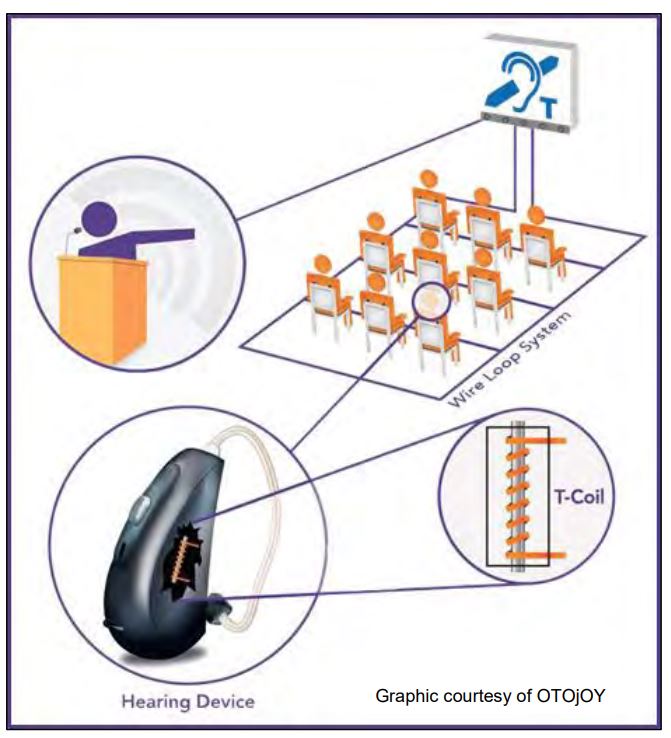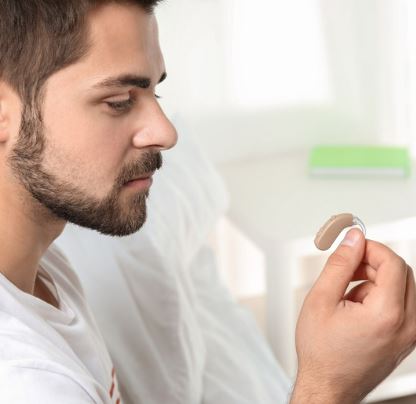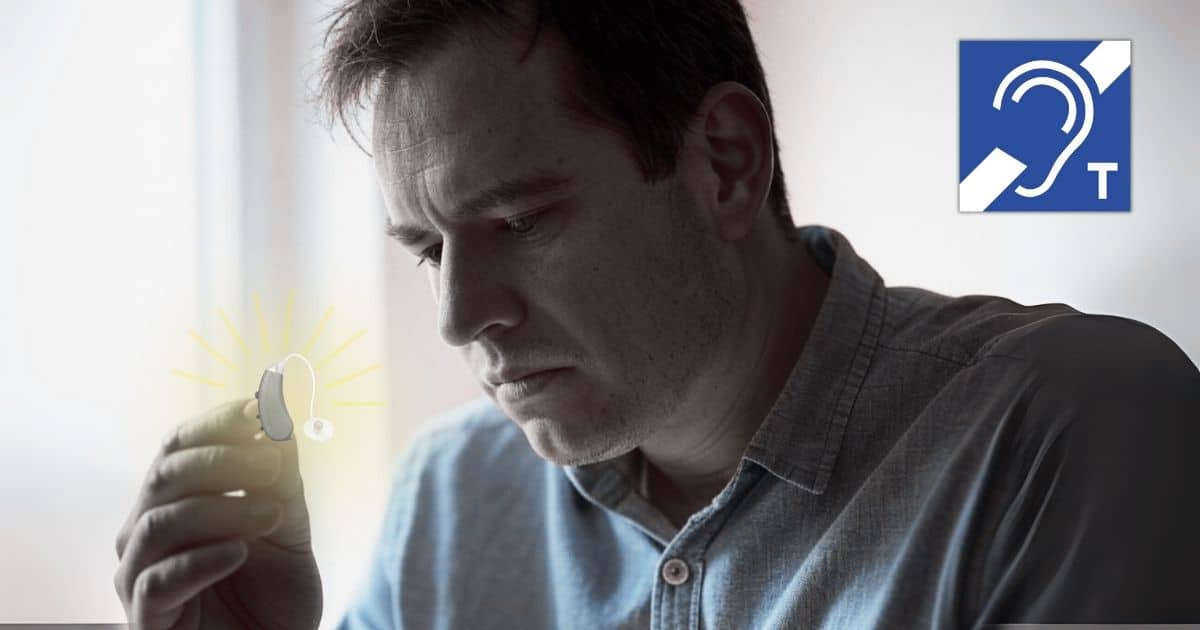By Stephen O. Frazier
My telecoil tale begins at my very first SHHH (now HLAA) meeting. Virginia Carr, the state’s SHHH chapter coordinator said, “Wait a minute, is the loop on? I can’t hear the loop.” I asked, “What’s a loop?” Virginia explained it’s a wire loop that silently sends sound to the telecoils in hearing aids. I then asked, “What’s a telecoil?” and she explained they are antennae in hearing aids that receive the signal from the loop. I made a mental note to check whether my hearing aids had telecoils.
They did not.
 Like many neophyte hearing aid buyers, I had not been told about this optional feature when fitted with the devices. The decision to include telecoils, which I had every right to make, had instead been made by my provider. I had been deprived of a feature that doubles the functionality of hearing aids, allowing users to hear in settings that had previously been problematic. When the time came to replace those hearing aids I was, again, not told about telecoils so I asked the audiologist if the hearing aids he was recommending had telecoils. He asked, “Why do you want those things?” I explained the local SHHH group had a hearing loop and I would also use them to hear when I talked on the telephone.
Like many neophyte hearing aid buyers, I had not been told about this optional feature when fitted with the devices. The decision to include telecoils, which I had every right to make, had instead been made by my provider. I had been deprived of a feature that doubles the functionality of hearing aids, allowing users to hear in settings that had previously been problematic. When the time came to replace those hearing aids I was, again, not told about telecoils so I asked the audiologist if the hearing aids he was recommending had telecoils. He asked, “Why do you want those things?” I explained the local SHHH group had a hearing loop and I would also use them to hear when I talked on the telephone.
Over the years I learned about neckloops that allowed me to connect to FM or Infrared assistive listening systems. I used one plugged into my cellular phone to talk hands free and with my landline phone for teleconferences. I now also use one for Zoom meetings to avoid creating feedback from a loudspeaker.
I installed loops in my living and dining rooms so I, and hard of hearing guests, could participate in conversations. I listened to Placido Domingo on an Iberia flight to Spain using my neckloop instead of the airline-issued earphones and heard the agent in a New York City subway booth thanks to the hearing loop installed there. Bluetooth and a remote mic might have worked for the latter but not easily for Domingo’s “Nessun Dorma.”
The availability of hearing loops in public spaces is expanding worldwide. Amtrak, like railroads abroad, is putting it in new passenger cars and ticket windows at stations. Over two dozen US airports now use one or more of the forms of hearing loops as do hundreds abroad. In New York, Broadway theaters and taxicabs now feature loops and thousands of places of worship are “looped” in America..
A survey recently conducted by the Committee for Communication Access in America (CCAA) has documented that the withholding of information on loops and telecoils is still going on. Asked, “Did the hearing care provider talk to you about telecoils before recommending and fitting you with your current hearing aids?”, 60% of respondents answered “no”. In fact, over 17% of them said they had not known about telecoils until they took the survey. 60% of respondents in the survey with a mild hearing loss indicated that telecoils would be a “must have” in the purchase of new hearing aids. The percent increased along with the degree of hearing loss. For those with profound loss it was 77%.

Advocates emphasize that the decision to include telecoils in hearing aids should rest with clients rather than providers.
Advocates for telecoils say the decision to include that option in their hearing aids should be the right of clients, not hearing care providers. The survey confirmed that, if given an unbiased, objective introduction to telecoil technology, the majority of hearing aid buyers will opt to have telecoils either in their hearing aids or in a remote mic that is also a hearing loop receiver.
In addition to their answers to specific questions, actual comments from the CCAA survey’s 1,500+ participants were included in the survey report. Those comments showed that many respondents, now educated on the matter, know that both Bluetooth® and telecoils will provide the greatest benefits – each offering specific features the other cannot match.
They’re even making a point of asking for them. Among those comments were the following:
When I asked my Audiologist, she said that it is not used anymore. She added it at my request…
My audiologist discouraged me from using a tcoils program but in talking with others who use them and my own experience with them I find them incredibly helpful.
My audiologist told me that Europe was much more accommodating. It would relieve a great deal of stress for me, especially in airports.
Needs to be a mandatory or regulatory requirement to ensure assistive hearing accommodations are available.
I had the hearing aids for 5 years not knowing that telecoil was an option on my hearing aids.
I read about telecoils and ask my audiologist about getting them with my last hearing aid purchase. I was advised against it.
Thanks for doing this survey. Hopefully telecoils will be more common. They are the best for auditorium/theater type venues.
I’m thrilled to see this survey going out to the public, and hope that not only venue owners/managers see this, but that manufacturers and audiologists realize that those of us who do not hear well need telecoils AND Bluetooth. Not one or the other. We need them both.
The day may be coming when I won’t need telecoils anymore – Auracast™ will have replaced it – but that day is many, possibly 10, years away. That’s how long it will take before hearing aid and cochlear implant users will all have transitioned from telecoils to Auracast.
Meanwhile, I’m getting ready. I plan on buying new state-of-the-art telecoil equipped hearing aids that are “Auracast ready”. I already have a Voce transceiver I can plug into my trusty old neckloop for access to any Auracast assistive listening system I encounter.
About the Author
 Stephen O. Frazier, trained by the Hearing Loss Association of America as a Hearing Loss Support Specialist, is a freelance writer with a focus on hearing loss issues. He was the organizer and chair of the Committee for Communication Access in America. He has presented workshops on a variety of hearing loss related topics to local, state and national audiences and his written work has appeared in most of the major hearing care and hearing loss related journals, blogs and newsletters. Many of his writings are posted at www.sofnabq.com. He can be reached at hlaanm@juno.com.
Stephen O. Frazier, trained by the Hearing Loss Association of America as a Hearing Loss Support Specialist, is a freelance writer with a focus on hearing loss issues. He was the organizer and chair of the Committee for Communication Access in America. He has presented workshops on a variety of hearing loss related topics to local, state and national audiences and his written work has appeared in most of the major hearing care and hearing loss related journals, blogs and newsletters. Many of his writings are posted at www.sofnabq.com. He can be reached at hlaanm@juno.com.






